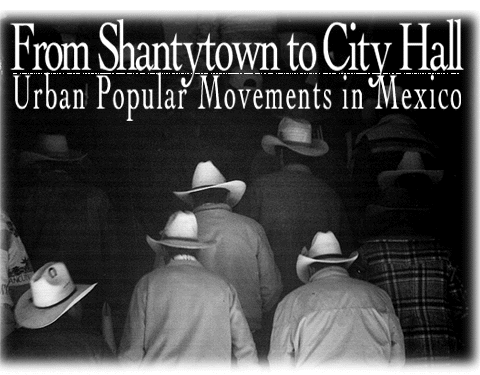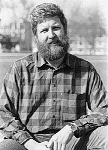SPRING 1998
Volume 15, Number 3

by Caroline Lupfer Kurtz
Photos by Paul Haber
 |
| Paul Haber |
After a trip from Manhattan to Mexico City and an all night bus ride into the hinterlands, Paul Haber remembers cooling his heels, tired and disoriented, in a small, busy office in downtown Durango, capital of the same-named state in north central Mexico. He had been waiting more than three hours to talk to Gustavo Ordaz, a leader of the Comite de Defensa Popular Fransciso Villa de Durango (CDP), one of a number of social movements forming in Mexico as a consequence of the dramatic shifts in the population and the economy since the early 1970s.
That was 1988. Haber had been in Mexico for two years as a graduate student from Columbia University, supported by the Fulbright and MacArthur foundations, learning about urban popular movements.
Now an associate professor of political science at The University of Montana, Haber is the unofficial archivist and historian of the CDP and has documented its transformation from a shantytown movement of rural poor into the leading political party in Durango, the largest and least populated state in Mexico. He does similar work with the Asemblea de Barrios in Mexico City, a confederation of large neighborhood organizations in the fifth most populous city in the world.
Much of Haber’s research involves “hanging out” in shantytowns to learn about the issues and the organizations. With his open demeanor and relaxed style, Haber fits into this scene better than many people could. Nevertheless, “it took a lot of ignorance and chutzpa on my part to get started,” he says.
Through interviews, participatory observation and sheer time spent listening to stories, Haber has followed the growth of these movements - how they have structured themselves and what they have achieved. This summer, he begins a year’s sabbatical to work on a book about urban popular movements in Mexico from 1979 to 1994, a summary of his research on the grassroots organizations that have been crucial to the growing democratization of Latin America.
 |
“My interest is in how popular movements organize themselves to take action and for what purposes, and whether this leads to political power or not,” he says. “My belief is that the quality of Latin American democracies, and perhaps their future success, is directly related to the relationship between political parties and these grassroots movements.”
From Country to City
Haber’s connection with Mexico began in 1979 when he spent a year in Michoacan studying agriculture and land issues as an undergraduate. At that time 65 percent of the Mexican population was rural and 35 percent lived in urban centers. By 1980, that ratio had reversed, and today nearly 75 percent of the population lives in cities.
While urban areas could at first absorb newcomers, by 1970 more and more immigrants were unable to find work or housing in the city centers to which they moved. The result has been burgeoning underground economies and the creation of colonias, or shantytowns, in many areas.
“Urban popular movements tend to mobilize around concrete issues, such as housing, services, education or health,” Haber says. “Their leaders sometimes come from the low-income rank and file members, but more often they are from very different class and educational backgrounds.”
In the CDP, he noticed that those in control were powerful, charismatic men, whereas the rank and file members from the colonias were predominantly poor women seeking help. By contrast, he says, the Asemblea de Barrios, while also largely low-income, has a much wider class representation. Its middle-level leaders come from the professional classes, resulting in a more democratic structure.
Land Invasions and
Political Power
In Durango, the shift from country to city took the form of “land invasions” and the creation of shantytowns on vacant parcels of land. Coordinated by members of a once powerful student movement, these invasions were violently repressed by the government in 1968.
 |
| A detail from a mural, painted by Diego Rivera, that hangs in Mexican National Palace. |
“They would occupy land at night, mostly public but some private, sometimes with the knowledge of officials who recognized that such settlements were inevitable and that it would be better if the government kept some kind of control,” Haber says.
Within ten years or so, Haber says that shantytown dwellers changed their approach. Instead of going “with hat in hand” to the government for what they wanted, they decided to become the government. “They began to see elections as a mechanism for social change, another way to get what they want,” he says.
Today the CDP controls the capital city; Durango’s last two mayors have been CDP members. At the state level, the CDP has changed its name to the Partido del Trabajo (Workers’ Party), and it is going to make a strong run for the governorship in 2000, according to Haber.
“The CDP has mitigated corruption, which is the basis for their broad electoral appeal,” he says. “They also have been more active than previous administrations in taking the initiative in public works and in trying to attract investment to create business opportunities for the people of Durango.”
Although it is a growing presence in municipalities, Haber says the CDP is very small at the national level, accounting for only six of the 500 seats in the Chamber of Deputies.
Out of the Rubble
Meanwhile, the Asemblea de Barrios has become a major player in the Partido de la Revolucion Democratica (PRD), the first real challenger to the Partido Revolucionario Institucional, which has ruled Mexico since the 1920s.
The Asemblea de Barrios came into being for very different reasons than the CDP, Haber says. It emerged from a coalition of neighborhood organizations after central Mexico City was devastated by an earthquake in September 1985. The downtown and historic zone, home to low- and moderate-income families, was coveted by developers and others who were kept at bay by long-standing rent-control laws. The earthquake was an opportunity for outside interests to move in and gentrify the area, threatening to displace residents. Neighborhood groups mobilized to fight this invasion and to insist that the government rebuild affordable housing downtown.
Paco Saucedo, a former Jesuit priest, is one of the leaders of the four main barrios that make up the Asemblea, and he and Haber have become close friends during the past decade. Saucedo’s philosophy and concern with the ethics of political movements have instructed and inspired Haber. “As the CDP and the Assemblea have grown and become involved in party politics, their members are challenged to maintain the ethical and philosophical convictions of their origins,” he says.
When he returns to Mexico this summer, Haber will be thinking about these issues. “Latin American politics have been transformed over the past generation,” he says. “In the late 1970s, the majority of nations were ruled by authoritarian regimes; today, the norm is representative democracy. But what difference does this make for low- and moderate-income people? Certainly, freedom from state terror and the restoration of democratic rights is a major plus. But what about the issues of economic and social justice? Can Latin American democracy continue in the face of the vast disparities in wealth and income that still characterize many countries?
“Grassroots movements express the will of the majority better than any other collective voice,” Haber says. “In determining how truly representative a government is going to be, you have to look at the relationship between political elites and grassroots organizations. The relation of social movements to political parties is integral to shaping the nature of these new democracies.” M
Writer Caroline Lupfer Kurtz is a regular contributor to UM’s Research View.